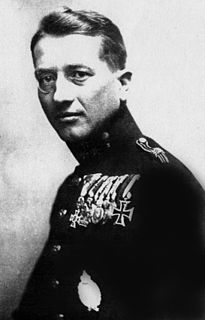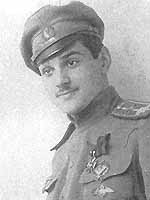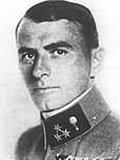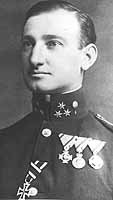
Julius Arigi was a flying ace of the Austro-Hungarian Empire in World War I with a total of 32 credited victories. He was Austro-Hungary's most highly decorated ace. His victory total was second only to Godwin von Brumowski. Arigi was considered a superb natural pilot. He was also a technical innovator responsible for engineering changes in the aircraft he flew.

Godwin von Brumowski was the most successful fighter ace of the Austro-Hungarian Air Force during World War I. He was officially credited with 35 air victories, with 8 others unconfirmed because they fell behind Allied lines. Just before the war ended, von Brumowski rose to command of all his country’s fighter aviation fighting Italy on the Isonzo front.
Hauptmann (Captain) Benno Fiala Ritter von Fernbrugg was an Austro-Hungarian fighter ace with 28 victories to his credit during World War I. He was the third ranking ace of the Austro-Hungarian Empire. His honours and decorations included the Order of the Iron Crown, Order of Leopold, Military Merit Cross, Military Merit Medal, Gold Medal for Bravery and the Iron Cross. He was also a technical innovator who pioneered the use of machine guns, radios, and cameras in airplanes. His forty-year aviation career also included aircraft manufacture, airport management, and the establishment of commercial airlines.

Cavalry Second Lieutenant Yury Vladimirovich Gilsher was a Russian fighter ace of World War I. Initially a cavalryman, but then an airman, Gilsher overcame two serious injuries to become an ace. After suffering a fracture of both bones in his right forearm, he later lost a foot to amputation because of a crash. He returned to duty with a prosthetic foot. Gilsher rose to his unit's command and scored five victories between April and July 1917 before being killed in action on 20 July 1917.
Capitano Giulio Lega was a World War I flying ace credited with five aerial victories. After finishing the war, he completed medical school, and began a near lifelong career caring for the Italian Chamber of Deputies.
Tenente Giovanni Sabelli was an Italian World War I flying ace credited with five aerial victories. At the start of World War I, he was already an experienced combat pilot.
Karl Urban was a World War I flying ace credited with five aerial victories.
Franz Wognar was an Austrian-Hungarian World War I flying ace credited with five aerial victories who held the rank of Offiziersstellvertreter.
Hauptmann Karl Nikitsch was a professional soldier who served, in succession, the Austro-Hungarian Empire and the First Austrian Republic. His First World War service in the Austro-Hungarian Imperial and Royal Aviation Troops was marked by his abilities in organizing, staffing, and commanding flying squadrons. He also became a flying ace credited with six aerial victories Postwar, he commanded the Austrian Flugpolizei.
Tenente Gastone Novelli was a World War I flying ace credited with eight aerial victories.
Hauptmann Heinrich (Jindřich) Kostrba was an Austro-Hungarian aviator, the first which to score three victories in a single day, on 18 February 1916, and three more on 29 June 1916. He went on to amass eight aerial victories and become a squadron leader and flying ace.

Oberst Adolf Heyrowsky, was a career officer in the Austro-Hungarian military who turned to aviation. He became an accredited flying ace during World War I, with twelve aerial victories scored despite the fact he was a reconnaissance pilot instead of flying fighters. The units he flew in and commanded had long range recon and ground attacks as their primary mission.

Kurt Gruber was an Austro-Hungarian flying ace during the First World War who held the rank of Offiziersstellvertreter. He was credited with eleven aerial victories, 5 shared with other pilots.
Oberleutnant Franz Rudorfer was an Austro-Hungarian World War I flying ace credited with eleven confirmed and two unconfirmed aerial victories.

Raoul Stojsavljevic was an Austro-Hungarian World War I flying ace credited with ten aerial victories. His later career took him to postwar service in aviation both military and civilian. His younger sister was the painter Mileva Roller and her husband was the artist Alfred Roller (1864–1935).
Oberleutnant Ernst Strohschneider was an Austro-Hungarian flying ace during World War I. He was credited with 15 confirmed aerial victories during his rise to the simultaneous command of two fighter squadrons. He died in a flying accident on 21 March 1918.
Feldwebel Stefan Fejes was an Austro-Hungarian flying ace credited with 16 confirmed and 4 unconfirmed aerial victories during World War I. By war's end, he had not only received numerous decorations, he had been personally promoted by his emperor.
Stabsfeldwebel Ferdinand Udvardy was a Hungarian conscript into the military of the Austro-Hungarian Empire who became a flying ace credited with nine aerial victories. Upon the dissolution of Austria-Hungary, Udvardy became a Hungarian citizen, and in the aftermath of World War I, defended his new nation against invasion.
Oberleutnant Georg Kenzian Edler von Kenzianshausen followed his father's profession of arms, and served the Austro-Hungarian Empire during World War I. He became a fighter ace, scoring eight aerial victories. After the dissolution of Austria-Hungary in the aftermath of World War I, he became a citizen of German Austria and defended his new nation against invasion.








